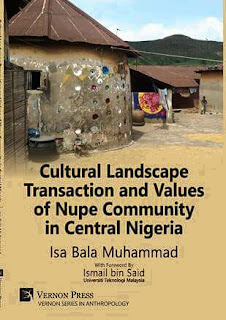Book Review || Cultural Landscape Transaction And Values Of Nupe Community In Central Nigeria
Author: Isa Bala Muhammad
Publisher: Vernon Press
Book length 122 43 b&w
illustrations
Reviewer: Abubakar Isah Danladi
The
book is an account of Nupe cultural landscape- a product of peoples' steady way
of life influenced by culture and landscapes' social transactions. It covers
Nupe cultural values with specific references to a typical Nupe community-
Doko. The output is largely from the inhabitants' perspective derived from an
ethnographic research compilation that led to grounded theory assertions. These
assertions evolved as the climax of the research from their unique tangible and
intangible values, belief and myth, a viewpoint showcasing inhabitants'
collective identity.
Nupe cultural values stem out into tripartite branches that cover landscape (e.g., hill or valley, water bodies, and market scenes), indigenous professions (e.g., farming, trading and traditional barbing) and architecture (e.g., compound design that includes bedroom, courtyard and entrance hut). The meanings derived from the values as lived by the people are common socio-spatial traits passed from generation to generation.
The
tangible physical features that are shaped by the intangible values as
elaborately discussed by the author are essential interpretations towards
sustainable rural development and nature conservation as realities essential
for planning, policy formation and developmental programmes. Significantly, the
meaning extracted from the cultural landscape transactions are expressed
spatially.
The book affirms the uniquely characterized cultural landscape transactions with overriding design implication that relates typical Nupe compound design influenced by Nupe family system. Furthermore, it showcases theoretical inference which exposes the need to focus on minority ethnic groups in order to preserve, sustain and as well understand cultural landscape transactions of such groups both by content and method. This is because interpretations of man-made features and human lived experiences exhibited in tangible and intangible forms constitute the mainstream values of inhabitants and contribute to environmental orderliness.
Invariably, developmental plans by governments could be optimised through the comprehension of peoples' living experiences such as provided in this book.
This
scholarly contribution is a valuable asset to architects, anthropologists,
psychologists, environmentalists, and sociologists. It also provides research
ethnographers with great benefits in understanding indigenous cultural
landscapes. Beyond these, the built environmentalists are impacted by the
sustainable human-place transactional ideals and insights in the book.
********
Abubakar Isah Danladi is of the Federal University of Technology, Minna, Nigeria
Abubakar Isah Danladi is of the Federal University of Technology, Minna, Nigeria

Comments
Post a Comment
We love to hear from you, share your comment/views. Thanks